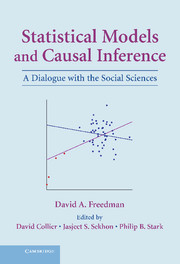Book contents
- Frontmatter
- Contents
- Preface
- Editors' Introduction: Inference and Shoe Leather
- Part I Statistical Modeling: Foundations and Limitations
- Part II Studies in Political Science, Public Policy, and Epidemiology
- 4 Methods for Census 2000 and Statistical Adjustments
- 5 On “Solutions” to the Ecological Inference Problem
- 6 Rejoinder to King
- 7 Black Ravens, White Shoes, and Case Selection: Inference with Categorical Variables
- 8 What is the Chance of an Earthquake?
- 9 Salt and Blood Pressure: Conventional Wisdom Reconsidered
- 10 The Swine Flu Vaccine and Guillain-Barré Syndrome: A Case Study in Relative Risk and Specific Causation
- 11 Survival Analysis: An Epidemiological Hazard?
- Part III New Developments: Progress or Regress?
- Part IV Shoe Leather Revisited
- References and Further Reading
- Index
10 - The Swine Flu Vaccine and Guillain-Barré Syndrome: A Case Study in Relative Risk and Specific Causation
Published online by Cambridge University Press: 05 June 2012
- Frontmatter
- Contents
- Preface
- Editors' Introduction: Inference and Shoe Leather
- Part I Statistical Modeling: Foundations and Limitations
- Part II Studies in Political Science, Public Policy, and Epidemiology
- 4 Methods for Census 2000 and Statistical Adjustments
- 5 On “Solutions” to the Ecological Inference Problem
- 6 Rejoinder to King
- 7 Black Ravens, White Shoes, and Case Selection: Inference with Categorical Variables
- 8 What is the Chance of an Earthquake?
- 9 Salt and Blood Pressure: Conventional Wisdom Reconsidered
- 10 The Swine Flu Vaccine and Guillain-Barré Syndrome: A Case Study in Relative Risk and Specific Causation
- 11 Survival Analysis: An Epidemiological Hazard?
- Part III New Developments: Progress or Regress?
- Part IV Shoe Leather Revisited
- References and Further Reading
- Index
Summary
Abstract. Epidemiologic methods were developed to prove general causation: identifying exposures that increase the risk of particular diseases. Courts often are more interested in specific causation: On balance of probabilities, was the plaintiff's disease caused by exposure to the agent in question? Some authorities have suggested that a relative risk greater than 2.0 meets the standard of proof for specific causation. Such a definite criterion is appealing, but there are difficulties. Bias and confounding are familiar problems; and individual differences must also be considered. The issues are explored in the context of the swine flu vaccine and Guillain-Barré syndrome. The conclusion: There is a considerable gap between relative risks and proof of specific causation.
Introduction
This article discusses the role of epidemiologic evidence in toxic tort cases, especially, relative risk: Does a relative risk above 2.0 show specific causation? Relative risk compares groups in an epidemiologic study: One group is exposed to some hazard–like a toxic substance; the other “control” group is not exposed. For present purposes, relative risk is the ratio
RR = Observed/Expected.
The numerator in this fraction is the number of injuries observed in the exposed group. The expected number in the denominator is computed on the theory that exposure has no effect, so that injury rates in the exposed group should be the same as injury rates in the control group.
- Type
- Chapter
- Information
- Statistical Models and Causal InferenceA Dialogue with the Social Sciences, pp. 151 - 168Publisher: Cambridge University PressPrint publication year: 2009

